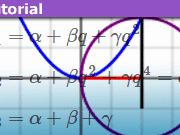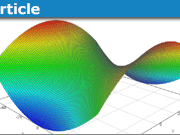Some Misconceptions on Indefinite Integrals
Integration is an incredibly useful technique taught in all calculus classes. Nevertheless, there are certain paradoxes involved with integration that are not easily solved. At least, I asked in my topology class whether anybody could resolve the paradox, and nobody found the correct answer.
The first paradox arises in the following integral:
[tex]\int \frac{1}{x} dx = \log |x|+C[/tex]
This is taught in any calculus class, but it is actually wrong. Indeed, how is this usually interpreted? It is interpreted as all the functions ##f(x)## whose derivative is ##1/x## is of the form ##\log|x|## plus some constant. That this interpretation is false can be seen by simply noting that the following function is not of that form but the derivative is ##1/x## nevertheless:
[tex]f(x) = \left\{\begin{array}{ll} \log x & \text{if}~x>0\\ 1+\log(-x) & \text{if}~x<0\end{array}\right.[/tex]
In fact, all the functions whose derivative is ##1/x## have the form
[tex]f(x) = \left\{\begin{array}{ll} \log(x) + C & \text{if}~x>0\\ \log(-x) +C’& \text{if}~x<0\end{array}\right.[/tex]
So there are two arbitrary constants involved, not one!
What goes wrong here? Well, everything relies on the theorem ##f’=g’## implies ##f=g+C##. This follows easily from the mean-value theorem. But the mean-value theorem is proven for functions ##f:[a,b]\rightarrow \mathbb{R}## which are continuous on ##[a,b]## and differentiable on ##(a,b)##. In our example with ##1/x##, the domain is ##\mathbb{R}\setminus\{0\}##, which is not an interval and cannot be written as an interval. So the traditional formula
[tex]\int f'(x)dx = f(x)+C[/tex]
is only valid if the domain is an interval. Otherwise, the structure of the integral is harder.
The second paradox involves an integration by parts. We have
[tex]\int \frac{1}{x} dx = 1 + \int \frac{1}{x} dx[/tex]
Cancelling both sides yields ##1=0##. What is going on?
Now we need to go back to the very definition of an indefinite integral. An indefinite integral is not just one function, it is a set of functions. Thus
[tex]\int f(x)dx = \{F~\vert~F’ = f\}[/tex]
What about our ##f(x)+C## notation then? That must be seen as an equivalence class. So we define on the set of functions the following: ##f\sim g## iff ##f’ = g’##. Then we can write the equivalence classes ##[f] = \{g~\vert~f\sim g\}##. It is now exactly the point that an indefinite integral is such an equivalence class, but we write this equivalence class (wrongly) as ##[f] = f+C##.
The operations on the equivalence classes are easy and natural:
- ##[f]+[g] = [f+g]##
- ##\alpha [f] = [\alpha f]##
- ##[\alpha] = [0]##
- ##0[f] = [0]##
with ##\alpha\in \mathbb{R}##
In our (wrong notation), things are a bit more awkward:
- ##(f+C) + (g+C) = (f+g)+C##
- ##\alpha (f+C) = (\alpha f) + C##
- ##\alpha + C = C##
- ##0(f+C) = C##
These look very weird, but solves our problem. Indeed, we know that
[tex]\int \frac{1}{x}dx = \log|x| + C = [\log|x|][/tex]
So we get that
[tex][\log|x|] = [1 + \log|x|] = [1]+[\log|x|][/tex]
So first integration by parts in our paradox is true, but only if we interpret integration by parts as
[tex]\int fg’ = [fg] + \int f’ g[/tex]
So ##fg## is an equivalence class and not a function.
Now it follows that
[tex][\log|x|] – [\log|x|]= [1]+[\log|x|] – [\log|x|][/tex]
which is also true, and from which follows
[tex][0] = [1][/tex]
which is true! But from this does not follow that ##0=1##.
Here is another example:
[tex]0 = 0\int xdx = \int 0x dx = \int 0 dx = C[/tex]
See if you can resolve this paradox using the equivalence class formalism.
See my next article: https://www.physicsforums.com/insights/friends-strangers-7825-computers/
Advanced education and experience with mathematics








Read the article again after a while. Very useful, certainly the part about the indefinite integral as equivalence relation. This is definitely the right way to interpret indefinite integrals.
in physics this would just be called sampling right?
[QUOTE="houlahound, post: 5575687, member: 551046"]are you free to make up any equivalence relationship?”Yes, you are free to make up any equivalence relationship. It just has to satisfy the properties. It has to be a relation and it has to be reflexive, symmetric and transitive.For instance, you could decide to use the relation where everything is equivalent to everything else. That is not likely to lead anywhere very interesting, but there is no rule saying that you cannot use that relation. That is how [much of] mathematics works. You set up rules and definitions, stick to them carefully and see where they lead.Edit to add:Note that nothing stops someone else from defining things differently. If you define equivalence one way and declare that sin x is equivalent to cos x for the purposes of one argument and if I define equivalence a different way so that sin x is not equivalent to cos x, there is no contradiction. Any statement either of us makes about the equivalence or lack thereof between the two functions needs to be understood in context. Both of us would have a duty to make it clear what definition of "equivalent" we are using.
thanks for explanation.further – so given;"In the case at hand, the equivalence relation is that two functions are equivalent if their first derivatives are identical as functions."then;y1 = 5x + 1andy2 = 5x + 7y1 and y2 are equivalent but y3 = 5x + 1 and y4 = 7x + 1 are not equivalent?are you free to make up any equivalence relationship?ie can I say that;given two functions are equivalent if the value of their first derivative is zero.eg;y1 = 2andy2 = Piare equivalent? or are there pre-defined laws on equivalence?
[QUOTE="houlahound, post: 5575591, member: 551046"]Thanks for great insight that even I as an amateur got a lot from.Can someone explain what the hell this means tho;Reference https://www.physicsforums.com/insights/misconceptions-indefinite-integrals/[alpha] = [0]”Start with the idea of an "equivalence relation". This is a relation that is reflexive, symmetric and transitive. Equality is one example of an equivalence relation. Modulus arithmetic is another. Two numbers are "equivalent modulo n" if they each have the same remainder upon division by n. In the case at hand, the equivalence relation is that two functions are "equivalent" if they differ by a constant. [A proof that this relation is reflexive, symmetric and transitive is left to the reader].Given a set (a set of functions in this case) and an equivalence relation, one can divide the set up into "equivalence classes" where every member of any particular equivalence class is equivalent to every other member.One can pick out a particular equivalence class by selecting a member, an "exemplar" of that class. The equivalence class selected in this manner is the set of all elements that are equivalent to the exemplar.The notation "[alpha]' in the article denotes the equivalence class whose exemplar is the constant function f(x) = ##alpha##The notation "[0]" denotes the equivalence class whose exemplar is the constant function f(x) = 0.And indeed, those two equivalence classes are identical.
Thanks for great insight that even I as an amateur got a lot from.Can someone explain what the hell this means tho;=Reference https://www.physicsforums.com/insights/misconceptions-indefinite-integrals/[alpha] = 0
[QUOTE="thierrykauf, post: 5575557, member: 553398"]Just like absolute value of x stands for two (not one) expressions, so does the shortcut C. When I learned this eons ago my teacher made it clear that C stood for two constants, one for each domain x < 0 and x>0.”Thanks for pointing this out – I had to look this up again because I'd long forgotten why. For the benefit of others in my position…There are two constants when integrating ##frac {1}{x}## because applying the fundamental theorem of calculus requires that the function be continuous over the interval we are interested in. For the indefinite integral, we are working with +/-##infty## BUT ##frac {1}{x}## is undefined when x=0, so its not continuous over our entire interval. To account for this, the integral must be evaluated on either side of the discontinuity, once for ##(-infty,0)## and ##(0,+infty)##. Each time this is done, we must use a different constant of integration.Had the function been something like ##frac {1}{(x-1)}## we would have had one constant for x < 1 and another for x > 1
Just like absolute value of x stands for two (not one) expressions, so does the shortcut C. When I learned this eons ago my teacher made it clear that C stood for two constants, one for each domain x < 0 and x>0.
[QUOTE="Mark44, post: 5575550, member: 147785"]I hope you aren't trying to conclude from this that 0 = 1.”Ha – very funny! o0)
[quote=ibkev]Therefore:$$int frac{1}{x} dx = 1 + int frac{1}{x} dx$$[/quote]I hope you aren't trying to conclude from this that 0 = 1.
[QUOTE="thierrykauf, post: 5575256, member: 553398"]I like to think that this has always been known and clear to everybody.”It really depends on people's backgrounds and how recently they've studied all this.[QUOTE="ibkev, post: 5563428, member: 568589"]Can someone explain where the equation comes from that the second paradox starts with? The one where the integrals on both sides cancel leaving 0 = 1?”This turns out to be because micromass can do integration by parts in his sleep and I had to think about it a bit :)In case it helps any other newbs out there, we want to solve:$$int frac{1}{x} dx$$Using integration by parts, whose formula is:$$int u dv=uv-int v du$$We substitute ##u=frac {1}{x}##, ##du=-frac{1}{x^2}dx## and ##dv=dx##, ##v=x## into the formula and find:$$= frac {1}{x}x-int x left( -frac {1}{x^2} dxright)$$Therefore:$$int frac{1}{x} dx = 1 + int frac{1}{x} dx$$
[QUOTE="thierrykauf, post: 5575256, member: 553398"]I like to think that this has always been known and clear to everybody.”How would you answer my question then?
I like to think that this has always been known and clear to everybody.
If you pick two separate constants for the 1/x integral, the formula won't work in the complex plane. log(x)+C continues to work in the complex plane as long as it is the same (single) value of C over all branches.For the second case, the paradox arises from the habit of leaving out the indefinite constants until the very end. Ordinarily, we work ahead without including the arbitrary constants which arise from each new integral, gumming them all up in the final +C we add at the very end. When the equation here finally reads 0=1, we have to remember that it should really read 0=1+C, where the single C is actually a combination of several arbitrary constants.If you want to be super pedantic about the C, you must remember that it arises from up to three indefinite integrals from the derivation of integration by parts, which STRICTLY readsint u dv = int d(uv) – int v dutl;dr there's always a +C floating around at the end of your equations when you integrate by parts. But for the same function, it had better be the same +C.
Good information, this.
Moderator's note: a fairly long series of posts based on a (now resolved) confusion have been removed.
[QUOTE="jbriggs444, post: 5565942, member: 422467"]That is not quite it. You do not integrate a number. You integrate a function. In this case a constant function whose value is zero everywhere. Its graph is a horizontal line — the x axis.The integral of a constant function is a family of linear functions all of whose graphs are parallel. In this case it is a family of constant functions whose graphs are horizontal lines. One of those lines happens to coincide with the x axis. There are other family members at every y value. However, none of the graphs are points. They are all horizontal lines and none of them coincide with the y axis.However, they all do intersect with the y axis and every point on the y axis is in the graph of a family member, so your mental picture is not completely incorrect.”awww yeah jeezz that 0 confused me somehow again… nevermind, i got it. thanks!
[QUOTE="LLT71, post: 5565914, member: 587786"]omg I feel so ashamed and silly atm :S sorry for making this discussion longer than it should be. totally my bad… you are right thats just one of the function from family. so indefinite integral of zero will be every point on y-axis? can I say "indefinite integral of 0 is one of the ways to define y axis?"?”That is not quite it. You do not integrate a number. You integrate a function. In this case a constant function whose value is zero everywhere. Its graph is a horizontal line — the x axis.The integral of a constant function is a family of linear functions. In this case it is a family of constant functions whose graphs are horizontal lines. One of those lines happens to coincide with the x axis. There are other family members at every y value. However, none of the graphs are points. They are all horizontal lines and none of them coincide with the y axis.
[QUOTE="jbriggs444, post: 5565867, member: 422467"]But that image is just plain silly. It is not the case that an indefinite integral of zero is uniquely zero.”omg I feel so ashamed and silly atm :S sorry for making this discussion longer than it should be. totally my bad… you are right thats just one of the function from family. so indefinite integral of zero will be every point on y-axis? can I say "indefinite integral of 0 is one of the ways to define y axis?"?
[QUOTE="LLT71, post: 5565846, member: 587786"]this:https://imagizer.imageshack.us/v2/342x80q90/924/Dg6XM0.jpgfrom this you can say that 0=C => C=0″But that image is just plain silly. It is not the case that an indefinite integral of zero is uniquely zero.
[QUOTE="jbriggs444, post: 5565838, member: 422467"]Again, what motivates you to write this series of equations? You are asserting that they hold for no apparent reason. And then solving them for no particular reason.”this:https://imagizer.imageshack.us/v2/342x80q90/924/Dg6XM0.jpgfrom this you can say that 0=C => C=0
[QUOTE="LLT71, post: 5565807, member: 587786"]I know you can't choose C whatever you want cause that parameter tells you there is a family of functions (not just one function). but again if you watch it as equality C=0 is the only solution for problem 0*F(x)+0*C = 0+0*C=0+0=0=0+0*C=0+C.”Again, what motivates you to write this series of equations? You are asserting that they hold for no apparent reason. And then solving them for no particular reason.”see that conslusion as "2*C=C" as I mentioned it few times, not 2*C=C where C=0 is the only solution.”What distinction are you making between "2*C=C" and 2*C=C?”write me step by step how would you than compute this integral ∫2xdx?”The class of functions given by f(x) = x^2 + C for some real C. That's by inspection. You can't solve that for C. C is a free parameter that picks a member from the family. All family members are solutions.
[QUOTE="jbriggs444, post: 5565784, member: 422467"]That assumption would be wrong. What would be true is that the set of values that could be found for 2*C when C is an unspecified real number are the same as the set of values that can be found for C when C is an unspecified real number.This fact does not allow you to conclude that 2*C = C and that the only real number is zero.Trying to determine a value for a variable parameter is a fool's errand. It can take on any value by design.”I know you can't choose C whatever you want cause that parameter tells you there is a family of functions (not just one function). but again if you watch it as equality C=0 is the only solution for problem 0*F(x)+0*C = 0+0*C=0+0=0=0+0*C=0+C.see that conslusion as "2*C=C" as I mentioned it few times, not 2*C=C where C=0 is the only solution.write me step by step how would you than compute this integral ∫2xdx?
[QUOTE="LLT71, post: 5565775, member: 587786"]it's like I made an assumption in some of the previous post 2*C=C”That assumption would be wrong. What would be true is that the set of values that could be found for 2*C when C is an unspecified real number are the same as the set of values that can be found for C when C is an unspecified real number.This fact does not allow you to conclude that 2*C = C and that the only real number is zero.Trying to determine a value for a variable parameter is a fool's errand. It can take on any value by design.
[QUOTE="jbriggs444, post: 5565738, member: 422467"]Again, you have not justified that penultimate equality: 0*F(x)+0*C = 0+C[You are also playing fast and loose, multiplying zero by things that are not numbers, but since you are only multiplying zero, we can let that slide]There is nothing wrong to say that there is some function from that family where C=0. But that is not the same as concluding that C=0.”it's like I made an assumption in some previous post 2*C=C I know that 2 can't be equal one, but in the integration (antiderivative part) it doesn't matter if I said 2*C or C. derivative of that part will be 0. it's like this x+1=2 than only possibility is that x must equal one. but if x+1 is my primitive function I dont care if 1 is 1, 1 can be any number (any constant, parameter) and hence (x+C)'=f(x)=1. so, obviously if you watch this 0*F(x)+0*C = 0+C from this perspective (the perspective of equation), to satisfy it you must say 0+C=0 => C=0 but if you watch it as whole 0*∫f(x)dx=0*(F(x)+C)=0*F(x)+0*C=0+C it doesn't matter if you said 0*C=C or 0*C=0 still => (F(x)+0)'= F'(x)+(0)'=F'(x)+(C)'=F'(x)=f(x)
[QUOTE="LLT71, post: 5565713, member: 587786"]sorry,my bad! but can you explain whats wrong with this statement:∫2*xdx=2*∫xdx=2*(x^2/2+C)=x^2+2*C(constant times constant = constant, which I think is the paradox part)”That is to say that the anti-derivative is a class of functions that can be parameterized as x^2 + 2C and letting C be the parameter. “if you differentiate x^2+2*C you will get function 2*x which is function inside the integral. same thing will happen if you let 2*C=C. no matter if you see it as n*C (n=const.) or just C it can still be treat as "any constant" cause if you differentiate any constant function, C or 2*C, you will get zero.”Yes indeed.”0=0*∫f(x)dx=0*(F(x)+C)=0*F(x)+0*C=0+C=C”Again, you have not justified that penultimate equality: 0*F(x)+0*C = 0+C[You are also playing fast and loose, multiplying zero by things that are not numbers, but since you are only multiplying zero, we can let that slide]”I guess thats the whole point of indefinite integration. find me such primitive functon F(x) that matches this equation F'(x)=f(x). and since (C)'=0 (C is constant) you can add that constant to F(x) and still nothing changes, you will get same result f(x), cause (F(x)+C)'=F'(x)+(C)'=F'(x)+0=F'(x)=f(x). F(x)+C are so called "family of functions" so whats wrong if you say "there is some function from that family where C=0"?”There is nothing wrong to say that there is some function from that family where C=0. But that is not the same as concluding that C=0.
[QUOTE="jbriggs444, post: 5565695, member: 422467"]Let us take a step backward. You had asserted:And now you say that this follows because:But the asserted equality does not take that form. It is a non-sequitur.”sorry,my bad! but can you explain whats wrong with this statement:∫2*xdx=2*∫xdx=2*(x^2/2+C)=x^2+2*C(constant times constant = constant, which I think is the paradox part)if you differentiate x^2+2*C you will get function 2*x which is function inside the integral. same thing will happen if you let 2*C=C. no matter if you see it as n*C (n=const.) or just C it can still be treat as "any constant" cause if you differentiate any constant function, C or 2*C, you will get zero. so:0=0*∫f(x)dx=0*(F(x)+C)=0*F(x)+0*C=0+C=C(0+C)'=(0)'=f(x)=0I guess thats the whole point of indefinite integration. find me such primitive functon F(x) that matches this equation F'(x)=f(x). and since (C)'=0 (C is constant) you can add that constant to F(x) and still nothing changes, you will get same result f(x), cause (F(x)+C)'=F'(x)+(C)'=F'(x)+0=F'(x)=f(x). F(x)+C are so called "family of functions" so whats wrong if you say "there is some function from that family where C=0"?
Let us take a step backward. You had asserted:[QUOTE="LLT71, post: 5565580, member: 587786"]0*F(x)+0*C=0+C”And now you say that this follows because:[QUOTE="LLT71, post: 5565660, member: 587786"]I can say 0*anything is 0.”But the asserted equality does not take that form. It is a non-sequitur.
[QUOTE="jbriggs444, post: 5565622, member: 422467"]Right. But why must that equation hold? You wrote it down, you must have a reason to assert that it holds.”if I try to explain my statement to anybody I would probably do it in a fashion of example below, and that is furthest point my knowlege reaches. again, I am not mathematician. I can say put 0 instead of 2 or put any number and all other is the same. I can say 0*anything is 0. for me thats enough but if that is not the best argument (and I assume it's not) please let me know I wouldn't mind deleting my posts.
[QUOTE="LLT71, post: 5565580, member: 587786"]i am not mathemathician but let me try my highscool version:”0*F(x)+0*C=0+C which says that in order to this equation to be true C must be zero, which is obvious.Right. But why must that equation hold? You wrote it down, you must have a reason to assert that it holds.”
[QUOTE="jbriggs444, post: 5565424, member: 422467"]Can you justify that step?”i am not mathemathician but let me try my highscool version:0*F(x)+0*C=0+C which says that in order to this equation to be true C must be zero, which is obvious. but at the same time if you let 0*C=0 equation is still valid 0=0+0. for example ∫2*xdx=2*∫xdx=2*(x^2/2+C)=x^2+2*C(constant times constant = constant, which I think is the paradox part)if you differentiate x^2+2*C you will get function 2*x which is function inside the integral. same thing will happen if you let 2*C=C. no matter if you see it as n*C (n=const.) or just C it can still be treat as "any constant" cause if you differentiate any constant function C or 2*C you will get zero.
[QUOTE="LLT71, post: 5564976, member: 587786"]0*F(x)+0*C=0+C”Can you justify that step?
I don't get why should we treat 0=C as paradox? I mean obviously it is but if you follow some basic rules for integration you will always get the right answer 0=00=0*∫xdx=∫0xdx)=∫0dx=0∫dx=0(x+C)=0*x+0*C=0+0=00=0*∫f(x)dx=0*(F(x)+C)=0*F(x)+0*C=0+0=0EDIT: I get it now…let a=const. => a∫f(x)dx=a*(F(x)+C)= a*F(x) + a*C = a*F(x) + C
Can someone explain where the equation comes from that the second paradox starts with? The one where the integrals on both sides cancel leaving 0 = 1?
[QUOTE="sholton, post: 5550888, member: 602119"]When we did integrals, we didn't look "backward" and consider the integral to be "interpreted as all the functions…". Instead, it was interpreted as :the area under the curve of the specified function;”That is indeed true for a definite integral, but this insight is considering indefinite integrals, which deals with the problem of finding antiderivatives.
When we did integrals, we didn't look "backward" and consider the integral to be "interpreted as all the functions…". Instead, it was interpreted as :the area under the curve of the specified function; in this case, the function is 1/x – in which case, the RHS is correct.Going back the other way doesn't work, b/c the integral doesn't actually represent "all the functions" – just the specified one. And you can't take the derivative of a discontinuous function (or a "not smooth" function) as represented by your RHS?
The first paradox was very cool but where did the equation come from that the second paradox starts with?
Great as always @micromass!
very interesting!
Great Insight MM!